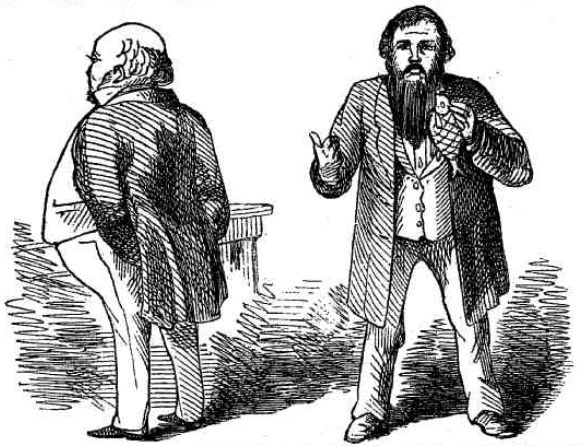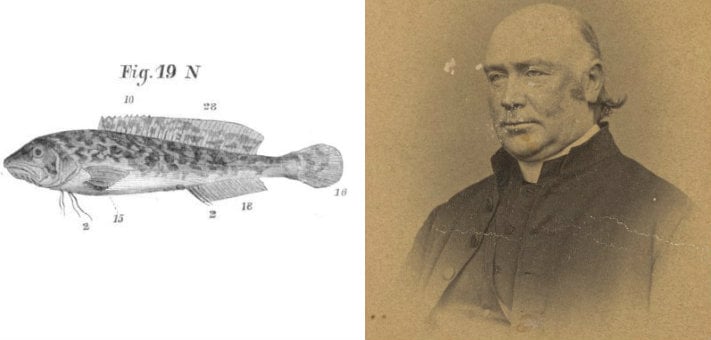Melbourne in the 1850s had a small but ambitious scientific community. One particularly idiosyncratic member of that community was William Blandowski, a man often at odds with the scientific establishment.
In 1856, Blandowski was named leader of an expedition studying the natural history of the Murray River. The expedition collected 17,000 specimens and in 1857 he presented a paper to the Philosophical Institute of Victoria that included his descriptions of a number of Murray River fish. [i]

Recent discoveries in natural history on the lower Murray by William Blandowski.
Blandowski had a combative relationship with some of the Philosophical Institute’s council. When he chose to name several fish after these men, they saw satire rather than honour in his choices.
Rev John Bleasdale and Dr Richard Eades were particularly affronted and accused Blandowski of naming them after especially ugly fish with unsightly habits.
Brosmius Bleasdalii was ‘a slimy, slippery fish. Lives in the mud. Is of violet bluish colour on the belly. The whole upper surface is of a dirty olivish-green colour, with numerous irregular dark patches.’
Cernua Eadesii, ‘a fish easily recognized by its low forehead, big belly and sharp spine.’ [ii]
So incensed were members of the council that Bleasdale and William Wilson (one of Melbourne University’s inaugural professors) threatened to resign. A special sub committee was formed to consider the matter.
Bleasdale and Blandowski from an image accompanying the satirical poem An Explanation Melbourne Punch 1 April 1858 p.1
The newspapers were greatly amused by the squabbling scientists. Again Melbourne Punch was to the fore:
We understand that the enquiry into Mr. Blandowski’s case and the stomachic considerations connected therewith is still pending. The gentleman who complained of the libellous insinuation, that he had a black stomach with blue spots, was for some time under a severe examination, but he emerged from it with a spotless reputation. [iii]
The normally sober Melbourne Argus joined in the fun.
The fish called after Dr.Eades was described as having a receding forehead and a large belly… If the Doctor be dissatisfied with his stomach and his forehead – and we trust that his distrust of them is altogether unfounded- neither Mr Blandowski nor Mr Blandowski’s fish is responsible for the misfortune. [iv]
The men and their fish
Brosmius Bleasdalii (left) and Rev Bleasdale (right) H3075
Cernua Eadesii (left) and Dr Richard Eades (right) IMP16/08/62/1
Unable to force Blandowski out of the Institute, the council forbade the publication of the descriptions of the fish in the Institute’s transactions.
 Text in the published Transactions in place of pages 131 – 134.
Text in the published Transactions in place of pages 131 – 134.
The Institute council, though, hadn’t counted on the collecting zeal of our Library. We have a copy of Mr Blandowski’s colourful and unexpurgated description of Eadesii and Bleasdalii. It has been digitised for the world to see, and is of far greater interest than it might have been if no-one had made a fuss of the names.
In characteristic style, Blandowski left Melbourne in a blaze of controversy, fighting for compensation while the government demanded the return of all the specimens he had collected.
Blandowski reached Hamburg in November 1859, living much of his remaining life in the Prussian province of Silesia (where he was born).
In 1862 he published a book of illustrations of his Murray River journey – Australien in 142 photographischen Abbildungen nach zehnjährigen Erfahrungen. This is a unique record of both the natural history of the area and the lives, customs and ceremonies of the local Aboriginal tribes, as interpreted by Blandowski.
The book is now an extraordinarily rare item with the only complete copy held at the State Library of Berlin. [v] Fortunately a facsimile copy in English was published in 2010. [vi]
Alas, as Blandowski’s names, descriptions and illustrations of the Murray River fish were omitted from the Philosophical Institute’s published transactions, they were not officially adopted. The fish he had described had to wait up to 50 years to be claimed and named by other scientists. [vii]
Sadly Blandowski spent his last years in an asylum where he died in December 1878.
No doubt he would have felt vindicated when the 150th anniversary of his Murray River expedition was marked by a special dedicated issue of the Royal Society of Victoria proceedings. [viii]
[i] Blandowski, William Recent discoveries in natural history on the Lower Murray Transactions of the Philosophical Institute of Victoria, January to December 1857, Vol. 2 pp 124-137.
[ii]Recent discoveries in natural history on the Lower Murray (the pages removed from the published transactions), p. 131 to 134 September 1857,
[iii]The Philosophical Institute Melbourne Punch April 8, 1858 p.2
[iv]Editorial The Argus 27 March 1858, p.4
[v] See the State Library of Berlin for a digitised copy of the original work Australien in 142 photographischen Abbildungen nach zehnjährigen Erfahrungen
[vi] Blandowski, William Australia : William Blandowski’s illustrated encyclopaedia of Aboriginal Australia / edited by Harry Allen.
[vii]Humphries, Paul Blandowski misses out: ichthyological etiquette in 19th-century Australia Endeavour Vol.27 No.4 December 2003 p. 165
[viii] William Blandowski and his contribution to Nineteenth century science and art in Australia Proceedings of the Royal Society of Victoria. Special issue Volume 121 Number 1. The Philosophical Institute of Victoria changed its’ name to the Royal Society of Victoria in 1859.




